The First English Bible
The First English Bible
by Chrysantus Ukachi
- Author: Myles Coverdale (1488-1568)
- Title: English Version of the Bible (Tyndale and Coverdale): Psalter of the Great Bible
- Date: c 4 October, 1535
- Edition: Coverdale1535
- Translator: Myles Coverdale
- Language: English
- Source: http://bdh-rd.bne.es/viewer.vm?id=0000121944&page=1
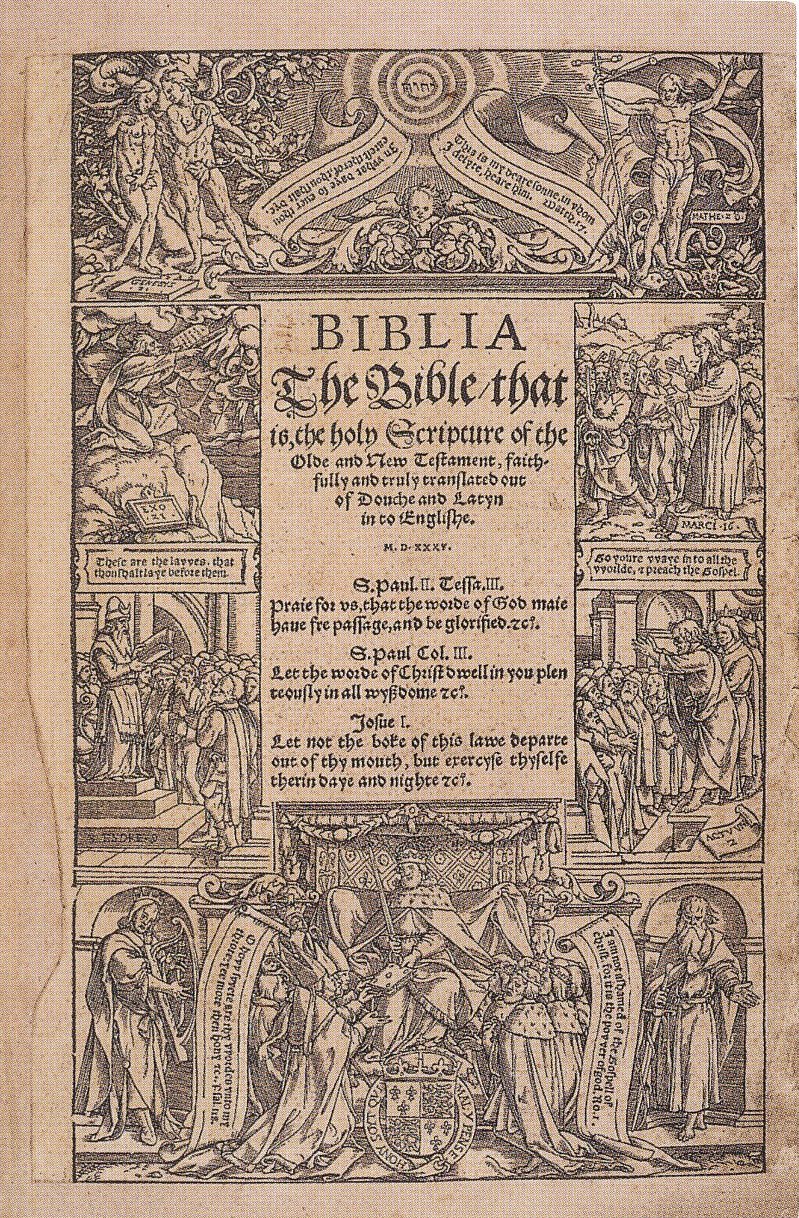
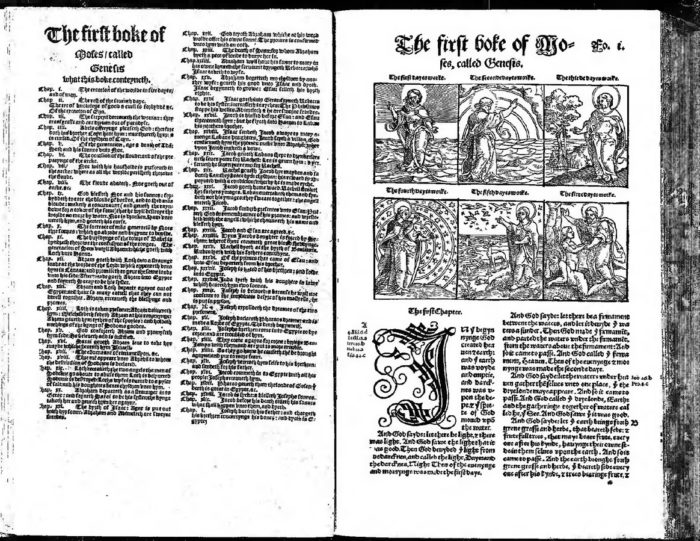
In the history of the English Bible, there are two outstanding names, William Tyndale and Myles Coverdale. While the former version of the bible of the first New Testament appeared in 1525 and the latter bore his name on the first complete Bible translated and printed. We can acknowledge that Coverdale gave practically his entire life to study the English scriptures. The publisher and place of printing of the 1535 bible have always been a mystery. Some scholars argue that the place has been Zurich, Frankfort, Cologne, or Paris. The work of translation was probably done at Antwerp and the volume was probably printed on the press of Forschover in Zurich. It was noted that Coverdale knew German and Latin extremely well and a little French The Great Bible of 1539 was the first authorized edition of the Bible in English, by King King Henry VIII of England to be read aloud in the church services of the Church of England.
Myles Coverdale prepared the Great Bible, working under the commission of Thomas Cromwell, chief minister and Secretary to Henry VIII. To follow the injunction of the King, in 1538, Cromwell directed the clergy to provide one book of the Bible of the largest volume in English, and the set up in some convenient places within the church that parishioners may constantly resort to and read. Here we have The second “Great Bible.” A new edition, with many corrections, of that published in April 1539 at the instance of Thomas Cromwell, Earl of Essex, and a copy of the Psalter of the Great Bible of 1539 a landmark in English literature.
Formal Aspect
The dimension of the bible is about 8-inches by 121/2 inches. It contains about 560 pages written in German-style English typeface, divided into two columns of 57 lines each. Customary to the time when this bible was written, the first letter of the first words of every chapter was in large and bold cursives (Early English Bible). The Coverdale Bible was so special that its cover and title page served as a pacesetter for other bibles following it. Additionally, the first edition of the Coverdale Bible was dedicated to King, Henry VIII and his wife Queen Anne. The Second edition was however dedicated to the king’s second wife Jane. Owing to the political circumstances of the time, especially with regards to the papacy, the introductory pages of the Coverdale bible included a denunciation of the pope (Early English Bible). Recall that it was during this time that the pope refused to grant Henry a divorce from his queen which led to the split between the Vatican and England. This split ultimately led to the creation of the Anglican Church (Early English Bible).
Before 1536, it was forbidden to produce a Bible in English. Those who could read and understand Latin controlled the Word of God. Nevertheless, in 1536, Henry VIII made it legal to translate the Bible into English, giving his people direct access to the Word of God. This was in line with wider religious reforms taking place on the continent, as part of the Reformation. The Reformation in England had begun in 1534 with the Act of Supremacy, making the monarch the Supreme Head of the Church, a situation that remains in place today. In 1547, a second and more radical Reformation replaced the Catholic Latin Mass and other rituals with an English Book of Common Prayer 1549. These services, written for the first time in English rather than Latin, transformed the Mass in England rite
The Psalm
The psalms during pre-modern Europe were central to the representation of political rule to this, researchers and scholars have long analyzed the use of the psalm and King David’s life by Henry VIII to understand and present his political power. David the writer and major actor of the psalm has different representations such as a shepherd, a child warrior, an adulterer, God anointed King, musician, and father of Solomon. It was regarded that Henry VIII was represented as David in a wide range in the 1530s as it was evident in the title page of the Coverdale Bible, the title pages of the Great Bible (1539), paintings, tapestries, manuscripts, decorations, and religious treatise.
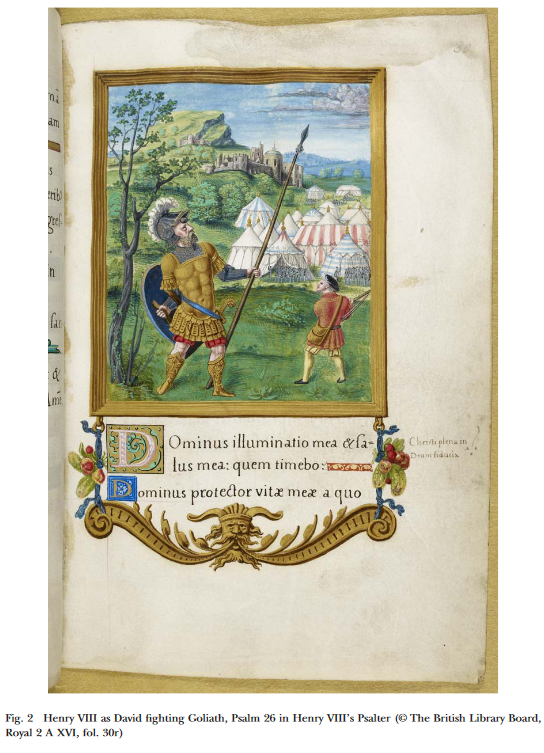
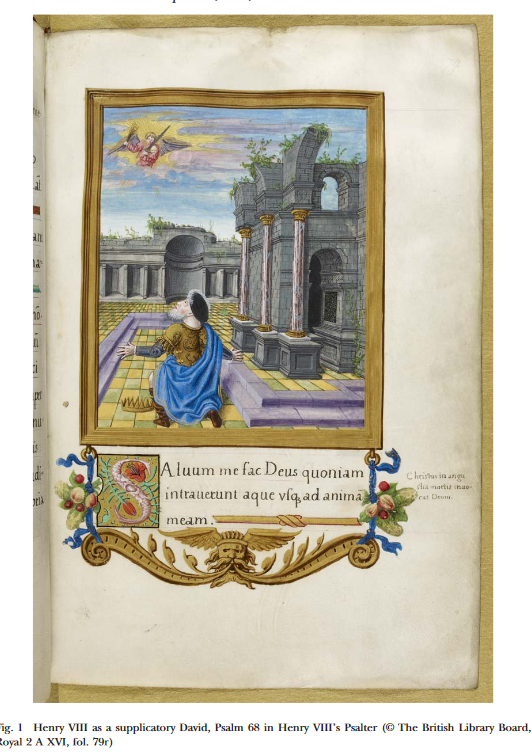
The Psalter contains the text of the Old Testament Book of Psalms. It has been a very important book among the books of the Bible divided up into groups of Psalms. They are often with beautified illumination, most frequently with images of King David, as a type of author portrait, or with extended sequences of prefatory miniatures. In the Roman Catholic all the Psalter 150 would be read by a monastic community throughout the course of a week, mainly at the hours of matins and vespers. The book of Psalms is one that is most known and influential as such it has gained highly and wide usage. The Psalm can be for liturgical activities, music production and composition of book of prayers chiefly the Divine Office (Breviary).
It was Coverdale’s English Psalter which was incorporated into the great Anglican Book of Common Prayer of 1662because it was more recognized by English readers and as such , most sensitive to the primary use of the Psalm as liturgical, forming the backbone of the daily offices of the church, morning and evening prayers in a never-ending cycle. His mastery of the simple phrase, use of image and sharp sense of rhythm make his translations particularly appropriate for the demands of chanting and singing.
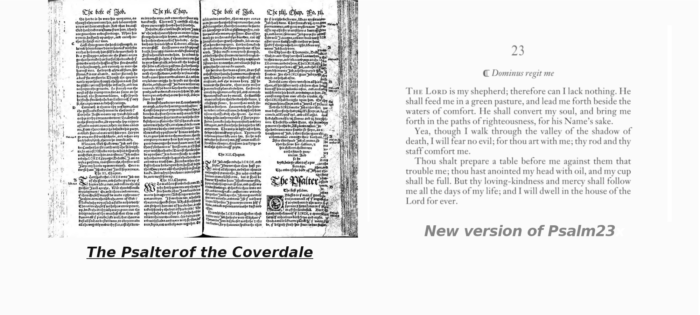
The Psalter of the Great Bible of 1539
The idea of the Bible as literature draws its point from the book of the psalms, which involved the school bible reading, daily recitation of the psalms as prayer, and teaching of the psalter with its usage. There was, for instance, an ecumenical effort to improve Irish education through the wider reading of the Bible in schools. Among all other English translations of the psalter, Coverdale’s psalter holds an eminent place. There have been changes in other books of the scripture but the psalm has retained its traditional diction and rhythm in rendition. The psalter of 1539 prepared by Coverdale has followed this strain. His version generated a new dialect in the English Language; it produced the most fitting type of diction. This new diction, despite the alteration and modification, reached such maturity and perfection, as made it the broad and solid platform of modern English. Furthermore, the English version of the psalter used in the Book of Common Prayer has directly or indirectly contributed to form the diction of almost every English writer such as David Hume and Robert Hall. Generally, this credit extends to the English bible of Coverdale that has served as a leading light and stability of the English language.
Sources:
[1] Smothers, Edgar R. “The Coverdale Translation of Psalm LXXXIV.” The Harvard Theological Review 38, no. 4 (1945): 245–69. http://www.jstor.org/stable/1508229.
[2] Peritz, Ismar J. “The Coverdale Bible 1535.” Journal of the National Association of Biblical Instructors 3, no. 2 (1935): 102–9. http://www.jstor.org/stable/1455777.
[3] White, Micheline. “The Psalms, War, and Royal Iconography: <em>Katherine Parr’s</Em> Psalms or Prayers <em>(1544) and Henry VIII as David</Em>.” Renaissance Studies 29, no. 4 (2015): 554–75. https://www.jstor.org/stable/26618814.
[4] TIPPLE, EZRA SQUIER. “Myles Coverdale and the First Printed English Bible.” Christian Education 19, no. 1 (1935): 3–8. http://www.jstor.org/stable/41176099.
[5] Jasper, David. “The Twenty-Third Psalm in English Literature.” Religion & Literature 30, no. 1 (1998): 1–11. http://www.jstor.org/stable/40059798.
References:
https://www.bl.uk/collection-items/the-great-bible-probably-henry-viiis-own-copy
https://archive.org/details/psalterofgreatbi00earl/page/158/mode/2up



